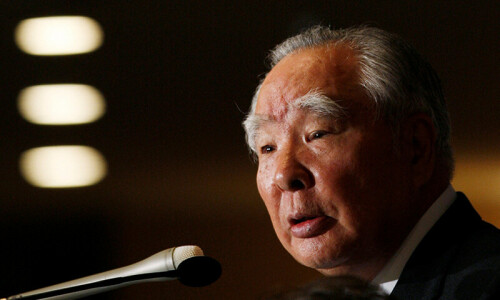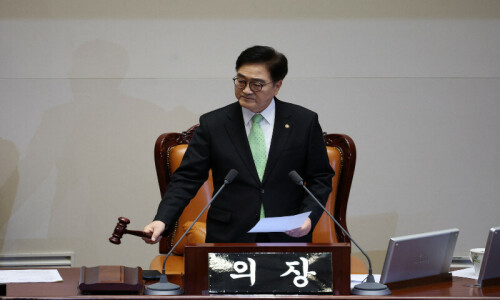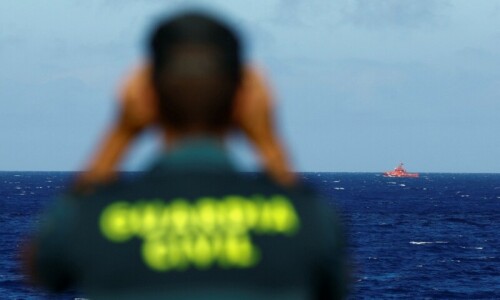Allahyar and the Legend of Markhor

In Allahyar and the Legend of Markhor, neither Allahyar nor the markhor (a screw-horn goat) have anything to do with the story, even though they are the title characters.
The story begins like this: a sepia-toned monologue tells us of an old sage who had the knowledge of the universe which somehow included how to communicate with animals. One day, the sage had to fend off a gargantuan snake, which he did with the help of a powerful markhor, the protector of the innocent. Centuries after the sage dies that power to talk to animals transfers into Allahyar, a young boy who has to help a young markhor find its way home to a far-off mountain. So off they go, meeting a chakor partridge (the best character in the movie) and a little snow leopard while avoiding a hunter (voiced by Ali Noor of pop band Noori) and a pack of wolves.
That being the entire story of the film, one wonders, like one wonders most of the time while watching Pakistani movies: who are the central characters and what are they doing in the movie? Surely, being an animated film there is a wealth of potential for storytelling and character depth here. What we learn is that the movie has a wealth of problems. First, the story: there is almost none. Characters meet, exchange a few lines and continue onwards to their destination. Nothing particularly eye-opening happens that would pull one’s emotional strings. Soon, every other scene becomes a variation of the previous one. Things become repetitive and boring, detaching one’s interest from Allahyar and Co. within the first 30 minutes. By the one-hour mark you begin to doze off.
Three films released last week all suggest a downward spiral for Pakistani cinema
Being bored in an animated film is a flabbergasting prospect. When the film literally runs out story elements, it jumps into back-to-back songs, as if desperate to complete its 90-minute running time. In the midst of boredom, the filmmakers try to lecture the audience on race, creed and religion or shoehorn real world issues like big-game hunting of endangered species (also the main reason markhors and snow leopards are in the cast, I gather). Neither aspect is handled with a deft touch. Camaraderie and friendship, the other core foundations of the story, find little support in the screenplay by Uzair Zaheer Khan (also the film’s director).
Speaking of writing, Allahyar’s dialogues are pedestrian and performed as if someone half-heartedly dubbed a Disney cartoon’s episode. This brings me to another let-down: the accents. Why do Allahyar, Mehru (the young markhor) and Chak’ku (the leopard) have an English-medium drawl from Clifton or Defence? Allahyar and the animals live somewhere in Pakistan’s northern areas, so was the urbanisation of accents and the inclusion of English within sentences necessary, especially when the film starts with an authoritatively worded Urdu monologue?
Technically, Allahyar will be praised for its animation. There is some truth in that argument. But Allahyar’s animation quality — the quality of the movement of the characters — is average, at best. Let me explain: in animation, characters are posed from one “key” frame to the other by an animator, and the frames in-between are smoothed out by the software. Detailed animation requires a lot of key frames which Allahyar doesn’t have (for those who have seen the film, note the movements of the leopard and the wolves, and how Allahyar moves his hands and body). This concept applies to motion captured performance from actors as well (Tintin, Polar Express, Beowulf and A Christmas Carol); so even if Allahyar’s animation depended entirely on technology and not human skill, it still falls short.
The film looks beautiful, but again, judging by today’s standards, that is no big feat. The output of animation, called rendering, has slowly defaulted to a photorealistic state with a practice called PBR (physically based rendering). PBR materials (think of it as a type of coating) are applied on 3D models which give them a realistic look, provided scenes are lit properly in the computer programme. PBR is now a standard global practice, one that is very easy to apply, so in my opinion Allahyar had no logical reason to not use it.
Coming back to bigger creative problems: almost every scene in Allahyar ends with a fade-out, whether the fade is warranted or not (technically, fades signify the end of a chapter or the passage of time). This practice becomes annoying really fast, especially when the plot moves to the wilderness and every scene ends up looking like the one before. The feeling is similar to being stuck in a perpetual déjà vu.
With the above mentioned arguments on the table, I was left with just one conclusion: Allahyar, regardless of its superficial gloss and hype, is a half thought-out amateur product. Last I heard, cinema was a professional medium. However, seeing the new set of lows from Pakistani releases in the last few years, I could be entirely wrong in my understanding of professionalism.
Speaking of writing, Allahyar’s dialogues are pedestrian and performed as if someone half-heartedly dubbed a Disney cartoon’s episode. This brings me to another let-down: the accents. Why do Allahyar, Mehru (the young markhor) and Chak’ku (the leopard) have an English-medium drawl from Clifton or Defence? Allahyar and the animals live somewhere in Pakistan’s northern areas, so was the urbanisation of accents and the inclusion of English within sentences necessary, especially when the film starts with an authoritatively worded Urdu monologue?
Pari

Right before the climax of Pari, one of its three main characters, the mother (Azekah Daniels) commits suicide. Driven by guilt, she believes she had no choice. At that moment I both sympathised and envied her. Fortunately, my pain didn’t last long, because I was saved by the very next scene.
Following her suicide attempt, the woman’s husband (Junaid Akhtar) takes her bleeding body to a hospital and is thunderstruck when he looks at photographs on a wall in front of him. “These three are the board of directors of the hospital,” someone tells the husband as he looks at the three pictures on the wall. In the middle is a colour portrait of the town loony, played by Saleem Mairaj. On Mairaj’s right and left are pictures of Gregory Peck and Omar Sharif. The guffaws that erupted after this revelation were involuntary and loud. This brief moment of homage has nothing to do with the film, but it did help alleviate a lot of the boredom.
For a horror film, being bored is the last thing one would expect. But then again, the experience reminds me of Aksbandh, another Pakistani horror film from two years ago that shares Pari’s creative and technical deficits.
Pari is about a demonically possessed child, her nearly atheist parents who live in a secluded house on top of a lonely hill, and a town loony. With such a miniscule premise, Pari’s makers (writer/director Syed Atif Ali in particular) would have been wise to keep the running time to under 90 minutes. One wishes the movie had ended by the intermission. But of course such wishes are never fulfilled.
Pari runs on bland (at times unintentionally funny) dialogue, flat performances and atrocious, de-saturated and uneven colour grading. The plot and the reasoning, which appear before the climax, are okay-ish. However, the set-up that leads to the very end is bizarre and, dare I repeat the word, amateurish. In a way, like the film before, the word suits the endeavour just fine.
Maan Jao Naa

As the last of the perfect trifecta of amateur feature films released last week, Maan Jao Naa (MJN) is bound to take pride as the most cinematic movie of the lot. Unfortunately, for MJN’s makers, being cinematic means only two things: shooting with out-of-focus backgrounds, and overly lighting the scene until there are literally no shadows on the cast or the set.
The lack of dimension doesn’t stop with the cinematography. The practice seeps right into the characters and the story.
Rania (Elnaaz Norouzi) is an arrogant, feminist young woman who abhors marriage yet has no problems singing and dancing in other people’s weddings. When forcefully betrothed to a rural-minded suitor, she runs away on their engagement day. Running away with Rania is her best buddy Faris (Adeel Chaudhry) who seemed to have nothing better to do. [Spoiler Alert] Faris eventually tells her that he loves her, and gets a slap on the face. Six months later, he falls for another girl (Ghana Ali), one who is a millionaire and runs an NGO for old people. By this time, as if one couldn’t guess from the trailer or the poster, Rania realises she loves him as well.
MJN is dead simple, unimaginative and very telefilm-like. In fact, the pacing, story-layout, the six-month break the characters take, and the climax, collectively hark back to early 2000s telefilms made by a couple of TV channels. The only difference between MJN and run-of-the-mill telefilms is that the former is shot on a digital cinema camera, and has a slightly bigger budget that includes a few songs and some very obvious production design (most scenes are shot indoors with texture-less, dimension-less, single-colour backdrops).
The cast, which includes Hajra Yameen and Ayaz Samoo in throw-away roles are, you guessed it, amateur performers. Norouzi in particular has a terrible, slightly nasal accent. The only good actor in the film was Asif Raza Mir, Norouzi’s stern-yet-sensible father. Director Aabis Raza and writers Asma Nabeel and Ahsan Raza Firdousi deliver a seen-it-all-before narrative brimming with lacklustre ambitions. In a medium whose main fuel is vivid imagination (which doesn’t necessarily need special effects or bloated budgets), we seem to be happy producing laughably mediocre cinema.
Published in Dawn, ICON, February 11th, 2018















































Dear visitor, the comments section is undergoing an overhaul and will return soon.